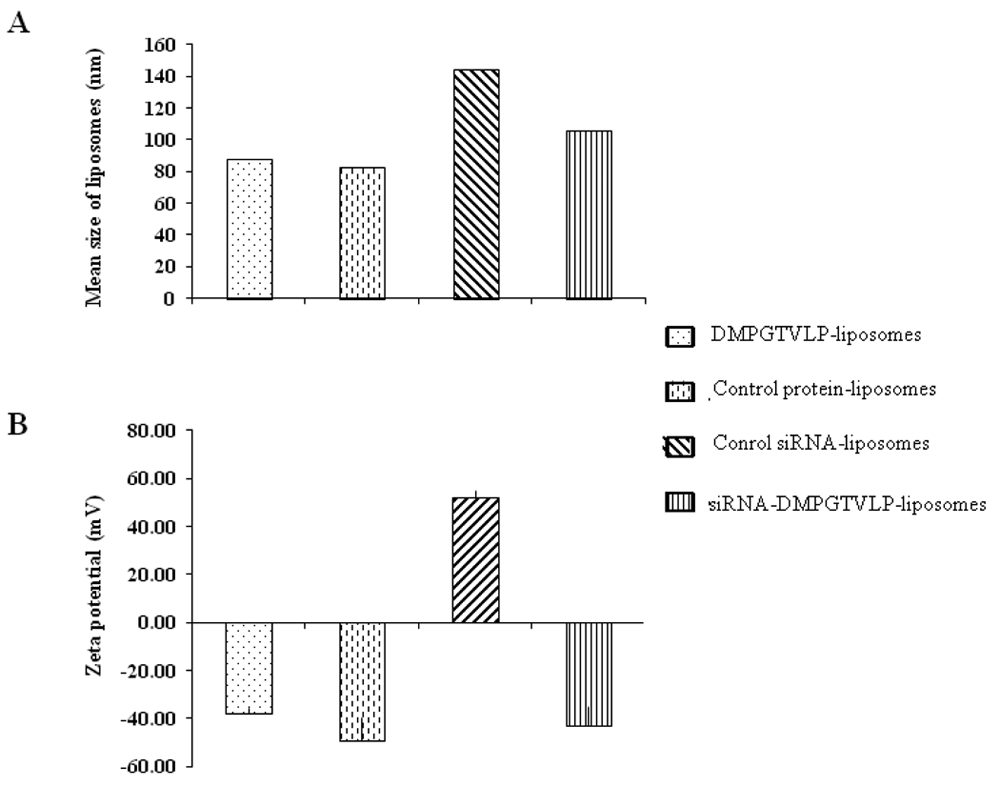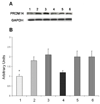Delivery of siRNA into breast cancer cells via phage fusion protein-targeted liposomes
- PMID: 21050894
- PMCID: PMC3108001
- DOI: 10.1016/j.nano.2010.10.004
Delivery of siRNA into breast cancer cells via phage fusion protein-targeted liposomes
Abstract
Efficacy of siRNAs as potential anticancer therapeutics can be increased by their targeted delivery into cancer cells via tumor-specific ligands. Phage display offers a unique approach to identify highly specific and selective ligands that can deliver nanocarriers to the site of disease. In this study, we proved a novel approach for intracellular delivery of siRNAs into breast cancer cells through their encapsulation into liposomes targeted to the tumor cells with preselected intact phage proteins. The targeted siRNA liposomes were obtained by a fusion of two parental liposomes containing spontaneously inserted siRNA and fusion phage proteins. The presence of pVIII coat protein fused to a MCF-7 cell-targeting peptide DMPGTVLP in the liposomes was confirmed by Western blotting. The novel phage-targeted siRNA-nanopharmaceuticals demonstrate significant down-regulation of PRDM14 gene expression and PRDM14 protein synthesis in the target MCF-7 cells. This approach offers the potential for development of new anticancer siRNA-based targeted nanomedicines.
From the clinical editor: In this study, the authors report a novel approach for targeted intracellular delivery of siRNAs into breast cancer cells through encapsulation into liposomes targeted to the tumor cells with preselected intact phage proteins.
Copyright © 2011 Elsevier Inc. All rights reserved.
Conflict of interest statement
There are no disclosures or any conflicts of interest with regard to this publication.
Figures







Similar articles
-
Non-viral nanocarriers for siRNA delivery in breast cancer.J Control Release. 2014 Sep 28;190:440-50. doi: 10.1016/j.jconrel.2014.05.037. Epub 2014 May 27. J Control Release. 2014. PMID: 24874288 Free PMC article. Review.
-
On the mechanism of targeting of phage fusion protein-modified nanocarriers: only the binding peptide sequence matters.Mol Pharm. 2011 Oct 3;8(5):1720-8. doi: 10.1021/mp200080h. Epub 2011 Jul 29. Mol Pharm. 2011. PMID: 21675738 Free PMC article.
-
Liposomes targeted by fusion phage proteins.Nanomedicine. 2009 Mar;5(1):83-9. doi: 10.1016/j.nano.2008.07.006. Epub 2008 Oct 1. Nanomedicine. 2009. PMID: 18838343 Free PMC article.
-
Enhanced binding and killing of target tumor cells by drug-loaded liposomes modified with tumor-specific phage fusion coat protein.Nanomedicine (Lond). 2010 Jun;5(4):563-74. doi: 10.2217/nnm.10.30. Nanomedicine (Lond). 2010. PMID: 20528452 Free PMC article.
-
Cell-specific siRNA delivery by peptides and antibodies.Methods Enzymol. 2012;502:91-122. doi: 10.1016/B978-0-12-416039-2.00005-7. Methods Enzymol. 2012. PMID: 22208983 Review.
Cited by
-
Advances with Lipid-Based Nanosystems for siRNA Delivery to Breast Cancers.Pharmaceuticals (Basel). 2023 Jul 6;16(7):970. doi: 10.3390/ph16070970. Pharmaceuticals (Basel). 2023. PMID: 37513882 Free PMC article. Review.
-
Non-viral nanocarriers for siRNA delivery in breast cancer.J Control Release. 2014 Sep 28;190:440-50. doi: 10.1016/j.jconrel.2014.05.037. Epub 2014 May 27. J Control Release. 2014. PMID: 24874288 Free PMC article. Review.
-
Effect of surface properties on liposomal siRNA delivery.Biomaterials. 2016 Feb;79:56-68. doi: 10.1016/j.biomaterials.2015.11.056. Epub 2015 Dec 2. Biomaterials. 2016. PMID: 26695117 Free PMC article. Review.
-
Targeted Gene Delivery to MCF-7 Cells Using Peptide-Conjugated Polyethylenimine.AAPS PharmSciTech. 2015 Oct;16(5):1025-32. doi: 10.1208/s12249-014-0208-6. Epub 2015 Feb 5. AAPS PharmSciTech. 2015. PMID: 25652728 Free PMC article.
-
Virus-modified exosomes for targeted RNA delivery; a new approach in nanomedicine.Adv Drug Deliv Rev. 2013 Mar;65(3):348-56. doi: 10.1016/j.addr.2012.07.006. Epub 2012 Jul 20. Adv Drug Deliv Rev. 2013. PMID: 22820525 Free PMC article. Review.
References
-
- Iorns E, Lord CJ, Turner N, Ashworth A. Utilizing RNA interference to enhance cancer drug discovery. Nat Rev Drug Discov. 2007;6:556–568. - PubMed
-
- Zheng X, Vladau C, Zhang X, Suzuki M, Ichim TE, Zhang ZX, et al. A novel in vivo siRNA delivery system specifically targeting dendritic cells and silencing CD40 genes for immunomodulation. Blood. 2009;113:2646–2654. - PubMed
-
- Pirollo KF, Chang EH. Targeted delivery of small interfering RNA: approaching effective cancer therapies. Cancer Res. 2008;68:1247–1250. - PubMed
-
- Wang W, Tang N, Zhang CL, Liu XJ, Hu H, Zhang ZX, et al. Cell penetrating peptides enhance intracellular translocation and function of siRNA encapsulated in Pegylated liposomes. Yao Xue Xue Bao. 2006;41:142–148. - PubMed
Publication types
MeSH terms
Substances
Grants and funding
LinkOut - more resources
Full Text Sources
Other Literature Sources
Medical

